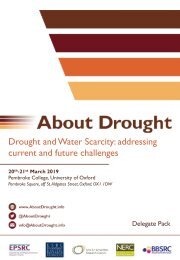About Drought Handbook: Outputs & Impacts
As the UK’s £12m Drought and Water Scarcity (DWS) research programme reaches its conclusion with a final event at The Royal Society in London, this handbook draws together the key outputs and outcomes. The book also features a series of interviews with our leading stakeholders, which highlight how successfully we have met our objectives to produce cutting-edge science that has made a demonstrable impact on how decision-makers manage water scarcity in the UK.
As the UK’s £12m Drought and Water Scarcity (DWS) research programme reaches its conclusion with a final event at The Royal Society in London, this handbook draws together the key outputs and outcomes. The book also features a series of interviews with our leading stakeholders, which highlight how successfully we have met our objectives to produce cutting-edge science that has made a demonstrable impact on how decision-makers manage water scarcity in the UK.
- No tags were found...
Create successful ePaper yourself
Turn your PDF publications into a flip-book with our unique Google optimized e-Paper software.
drought management and planning,<br />
and to facilitate more informed<br />
and effective public discourse<br />
related to drought. We envisage the<br />
conceptual framework will also be<br />
applied in other research settings,<br />
and also other environmental<br />
problems beyond drought, in the<br />
UK and internationally.<br />
Sectoral datasets and<br />
analyses<br />
Historic <strong>Drought</strong>s set out to<br />
improve our understanding of past<br />
droughts from a range of ‘sectoral’<br />
perspectives, before bringing these<br />
together in the <strong>Drought</strong> Inventory.<br />
This has led to a wealth of new<br />
datasets on drought, which are<br />
mentioned briefly below but which<br />
are listed in detail on page 46 of this<br />
<strong>Handbook</strong>.<br />
A key foundation of Historic<br />
<strong>Drought</strong>s is hydrometeorological<br />
reconstruction, aiming to improve<br />
our understanding of past drought<br />
occurrence and severity across the<br />
UK. Underlying this was a major<br />
data rescue and recovery exercise<br />
undertaken by the Met Office,<br />
who digitized hundreds of past<br />
weather records to improve the<br />
national network of raingauge and<br />
temperature observations in the<br />
late 19th and early 20th centuries<br />
especially. This effort has led to a<br />
major strengthening of our national<br />
climate archives, and extension<br />
of the datasets back to 1862. Not<br />
only is this beneficial for Historic<br />
<strong>Drought</strong>s, however – the rescued<br />
data features in the Met Office’s<br />
recently released ‘HadUK’ archive<br />
of national climate data, available<br />
to all. The temperature dataset<br />
has then been used by the CEH<br />
team to reconstruct a national,<br />
gridded daily evaporation dataset,<br />
extending back to 1891. The new<br />
historical rainfall and evaporation<br />
datasets were run through<br />
hydrological and hydrogeological<br />
models to reconstruct river flows<br />
and groundwater back to 1891,<br />
for over 300 river catchments and<br />
50 boreholes across the UK. This<br />
represents a significant advance in<br />
national hydrological datasets, as<br />
a majority of observed river and<br />
groundwater datasets start in the<br />
1960s. We have published these<br />
datasets on the Environmental<br />
Informatics Data Centre to make<br />
them available, and developed web<br />
tools to allow users to explore<br />
them.<br />
The new datasets have also allowed<br />
novel analyses that have allowed us<br />
to better characterise UK droughts<br />
back to the late 19th century. We<br />
have examined the frequency and<br />
severity of past hydrological drought<br />
episodes and quantified changes<br />
over time. We have also examined<br />
the spatial coherence of drought,<br />
regionally and nationally, and<br />
explored the spatial and temporal<br />
evolution of major past drought<br />
episodes. We have also improved<br />
understanding of drought processes,<br />
especially the atmospheric / oceanic<br />
drivers of droughts in the UK.<br />
The hydrometeorological analysis<br />
allows us to characterise the<br />
occurrence of drought as a natural<br />
hazard over the last 120 years, and<br />
has shed significant new light on<br />
past episodes that occurred before<br />
the start of most observed river<br />
flow and groundwater records (e.g.<br />
1890 – 1910, 1921-22, 1933-34 and<br />
through the 1940s).<br />
But from a societal or environmental<br />
perspective, drought impacts are<br />
the most important aspect, and to<br />
help inform future management<br />
strategies we need to investigate<br />
the human responses that have been<br />
taken to mitigate these impacts. We<br />
have built up a range of datasets<br />
characterising these aspects from<br />
various sectoral perspectives. As<br />
this has used a range of disparate<br />
source datasets and methodological<br />
approaches across several<br />
disciplines, a key component of this<br />
has been a standardized approach<br />
to collecting information, including<br />
a consistent approach to capturing<br />
when and where the relevant<br />
impact / action occurred.<br />
From an environmental perspective,<br />
our focus has been on quantifying<br />
Credit: Ned Hewitt<br />
19 19




